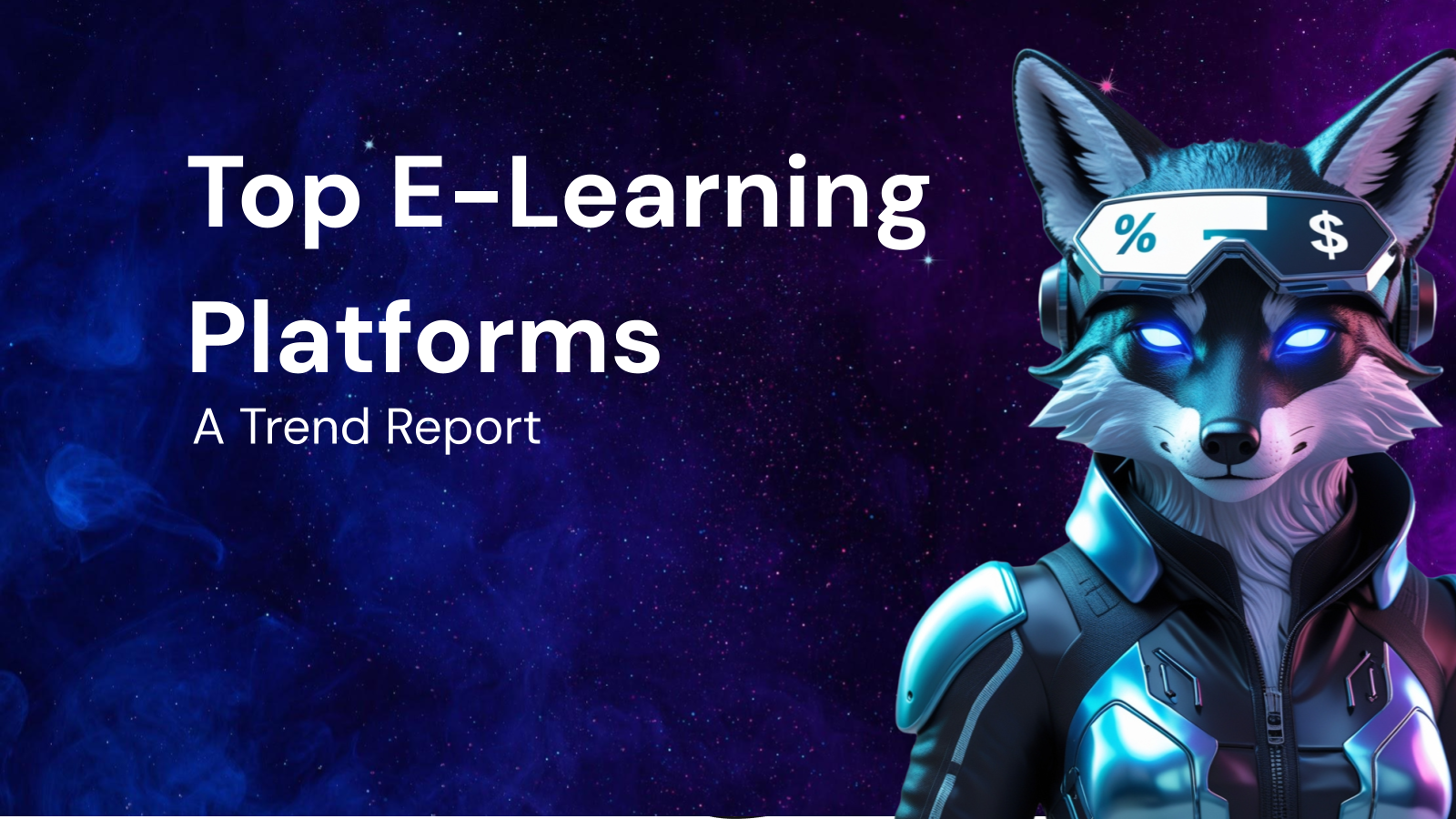Top 10 E-Learning Platforms: A Trend Report on Current Leaders

Top 10 E-Learning Platforms: A Trend Report on Current Leaders
The e-learning industry has exploded in recent years, transforming the way we learn, acquire new skills, and advance our careers. Driven by technological advancements, increased internet accessibility, and a growing demand for flexible and personalized learning experiences, the global e-learning market is projected to reach staggering heights in the coming years. This growth has led to a proliferation of e-learning platforms, each vying for a piece of the pie and catering to diverse learning needs.
Navigating this landscape can be daunting for both learners and educators. Which platform offers the best value? Which one aligns with specific learning objectives? Which one is best suited for corporate training or individual skill development? This report aims to shed light on these questions by analyzing the current top 10 e-learning platforms, highlighting their strengths, weaknesses, and key trends that are shaping the future of online education.
Methodology
The selection of the top 10 platforms is based on a multi-faceted approach, considering factors such as:
- Market Share and User Base: The platform's overall popularity and adoption rate.
- Course Variety and Quality: The breadth and depth of course offerings, as well as the credibility and expertise of instructors.
- User Experience (UX) and Interface: The platform's ease of use, navigation, and overall design.
- Pricing and Accessibility: The cost-effectiveness and affordability of the platform, including subscription models and free resources.
- Technology and Innovation: The platform's integration of emerging technologies, such as AI, VR/AR, and personalized learning algorithms.
- Features and Functionality: The availability of features like interactive learning tools, assessment options, community forums, and mobile accessibility.
- Reputation and Reviews: User feedback, expert opinions, and industry recognition.
The Top 10 E-Learning Platforms: A Deep Dive
Here’s a detailed look at the leading platforms shaping the e-learning landscape, ranked based on the above criteria (though rankings can be subjective and fluctuate):
1. Coursera: The Academic Powerhouse
Coursera stands out as a leader in offering university-level courses, Specializations, and degrees online. Partnering with prestigious universities and institutions worldwide, Coursera provides access to high-quality academic content across various disciplines.
- Strengths:
- Prestigious Partnerships: Collaborations with top universities like Stanford, Yale, and the University of Michigan guarantee high-quality content and recognized credentials.
- Academic Rigor: Courses are designed with a focus on academic rigor, offering in-depth knowledge and critical thinking skills.
- Degree Programs: Enables learners to pursue complete online degrees, enhancing career prospects.
- Specializations: Focused series of courses that allow learners to master a specific skill or subject area.
- Strong Community Features: Provides opportunities for interaction and collaboration among learners and instructors.
- Weaknesses:
- Pricing: Degree programs and some Specializations can be expensive.
- Time Commitment: Courses often require a significant time commitment due to their academic depth.
- Less Focus on Vocational Skills: While career-focused courses exist, the platform's primary strength lies in academic disciplines.
- Key Trends and Innovations:
- Microcredentials: Offering shorter, stackable credentials that validate specific skills and competencies.
- AI-Powered Learning: Utilizing AI to personalize learning paths and provide targeted feedback.
2. edX: The Non-Profit Advantage
Founded by Harvard and MIT, edX is a non-profit platform committed to providing accessible education to learners worldwide. It shares many similarities with Coursera but distinguishes itself through its open-source platform and non-profit mission.
- Strengths:
- Non-Profit Mission: Focuses on democratizing education and making it accessible to a global audience.
- Open-Source Platform: Allows for customization and collaboration, promoting innovation in online learning.
- High-Quality Content: Courses are developed by leading universities and institutions.
- Affordable Options: Offers free audit options for many courses, allowing learners to access content without paying for certification.
- Weaknesses:
- Limited Course Variety Compared to Coursera: While the platform offers a wide range of courses, the selection may be smaller than Coursera.
- Interface Can Feel Less Polished: Some users find the platform's interface less intuitive than other platforms.
- Key Trends and Innovations:
- MicroBachelors Programs: Focused on providing job-ready skills and credentials in high-demand fields.
- Emphasis on Open Educational Resources (OER): Promoting the use and creation of freely accessible educational materials.
3. Udemy: The Marketplace of Knowledge
Udemy operates as a vast marketplace for online courses, offering a wide range of topics taught by independent instructors. This platform distinguishes itself through its extensive course catalog, affordable pricing, and focus on practical skills.
- Strengths:
- Vast Course Catalog: Offers an unparalleled selection of courses on virtually every imaginable topic.
- Affordable Pricing: Courses are often heavily discounted, making them accessible to a wide range of learners.
- Practical Skills Focus: Many courses emphasize practical skills and hands-on learning.
- Instructor Autonomy: Instructors have complete control over their course content and pricing.
- Weaknesses:
- Variable Course Quality: Course quality can vary significantly due to the open marketplace model.
- Lack of Formal Accreditation: Courses do not typically lead to formal academic credentials.
- Over-Reliance on Discounts: The constant availability of discounts can devalue the perceived worth of courses.
- Key Trends and Innovations:
- Personalized Recommendations: Utilizing data to recommend relevant courses based on learner interests and goals.
- Emphasis on Mobile Learning: Optimizing the platform for mobile access and learning on the go.
4. LinkedIn Learning: The Career Accelerator
LinkedIn Learning leverages the power of the LinkedIn network to offer courses focused on professional development and career advancement. It's a powerful tool for upskilling and reskilling in today's competitive job market.
- Strengths:
- Career-Focused Content: Courses are designed to enhance professional skills and advance career prospects.
- Integration with LinkedIn Profile: Allows learners to showcase completed courses and skills on their LinkedIn profile.
- Expert Instructors: Features courses taught by industry experts and thought leaders.
- Data-Driven Insights: Provides insights into in-demand skills and career paths.
- Weaknesses:
- Limited Scope Beyond Professional Development: Less focus on academic subjects or personal development topics.
- Subscription-Based Model: Requires a paid subscription to access the full course library.
- Key Trends and Innovations:
- Skills Graph: Mapping the relationships between skills and job roles to guide learners toward relevant learning paths.
- Personalized Learning Paths: Utilizing AI to create personalized learning experiences based on individual career goals.
5. Skillshare: The Creative Hub
Skillshare caters to creative learners, offering courses in design, illustration, photography, writing, and other artistic disciplines. It provides a platform for both learning and showcasing creative work.
- Strengths:
- Focus on Creative Skills: Specializes in courses that foster creativity and artistic expression.
- Project-Based Learning: Emphasizes hands-on learning through projects and assignments.
- Community Engagement: Fosters a strong sense of community among creative learners.
- Affordable Subscription Model: Offers unlimited access to courses for a monthly subscription fee.
- Weaknesses:
- Lack of Formal Accreditation: Courses do not typically lead to formal academic credentials.
- Variable Instructor Quality: Course quality can vary depending on the instructor's expertise.
- Key Trends and Innovations:
- Live Classes: Offering live, interactive sessions with instructors.
- Focus on Short-Form Content: Creating shorter, more digestible courses for busy learners.
6. FutureLearn: The Social Learning Platform
FutureLearn distinguishes itself through its emphasis on social learning, encouraging collaboration and discussion among learners. Partnering with universities and cultural institutions, it offers a diverse range of courses across various disciplines.
- Strengths:
- Social Learning Focus: Promotes collaboration and discussion through forums and peer review.
- Partnerships with Reputable Institutions: Collaborates with universities and cultural institutions to offer high-quality content.
- Flexible Learning Options: Offers a variety of learning formats, including short courses, microcredentials, and degrees.
- Free Audit Option: Allows learners to access course content for free without certification.
- Weaknesses:
- Limited Course Variety Compared to Udemy: The course catalog is smaller than some of the larger platforms.
- Interface Can Feel Cluttered: Some users find the platform's interface a bit overwhelming.
- Key Trends and Innovations:
- Microcredentials: Offering shorter, stackable credentials that validate specific skills and competencies.
- Emphasis on Global Perspectives: Courses often incorporate diverse perspectives and address global issues.
7. Pluralsight: The Tech Skill Builder
Pluralsight is a leading platform for technology professionals, offering courses and skill assessments focused on software development, IT operations, and data science. It's a valuable resource for staying current with the latest technologies.
- Strengths:
- Tech-Focused Content: Specializes in courses that develop technical skills in software development, IT, and data science.
- Skill Assessments: Offers assessments to measure and track skill proficiency.
- Hands-On Learning: Emphasizes practical learning through coding exercises and real-world projects.
- Expert Instructors: Features courses taught by industry experts and thought leaders.
- Weaknesses:
- Limited Scope Beyond Technology: Less focus on non-technical subjects.
- Subscription-Based Model: Requires a paid subscription to access the full course library.
- Key Trends and Innovations:
- Adaptive Learning: Utilizing AI to personalize learning paths and provide targeted feedback.
- Hands-On Labs: Providing virtual environments for practicing coding and IT skills.
8. MasterClass: Learn from the Masters
MasterClass takes a unique approach by offering courses taught by renowned experts and celebrities in their respective fields. It provides an opportunity to learn from the best in the world, gaining insights and inspiration.
- Strengths:
- Expert Instructors: Features courses taught by renowned experts and celebrities.
- High-Quality Production: Courses are produced with high production values, creating an engaging learning experience.
- Inspirational Content: Provides insights and inspiration from leading figures in various fields.
- Weaknesses:
- Limited Interactivity: Courses are primarily lecture-based, with limited opportunities for interaction.
- High Subscription Cost: Requires a relatively expensive subscription to access the full course library.
- Focus on Inspiration Over Practical Skills: While insightful, the courses may not always provide practical skills for immediate application.
- Key Trends and Innovations:
- Expansion into New Categories: Expanding course offerings beyond traditional arts and entertainment to include business, science, and technology.
- Community Features: Introducing features that allow learners to connect and share their experiences.
9. Udacity: The Nanodegree Innovator
Udacity is known for its Nanodegree programs, which are designed to provide in-demand skills for specific tech jobs. It partners with leading technology companies to develop industry-relevant curriculum.
- Strengths:
- Industry-Relevant Curriculum: Nanodegree programs are developed in collaboration with leading technology companies.
- Project-Based Learning: Emphasizes hands-on learning through real-world projects.
- Career Services: Provides career coaching and job placement assistance to graduates.
- Weaknesses:
- High Cost of Nanodegree Programs: Nanodegree programs can be expensive.
- Limited Course Variety Beyond Tech: Less focus on non-technical subjects.
- Key Trends and Innovations:
- Focus on Emerging Technologies: Courses are often focused on cutting-edge technologies like artificial intelligence, blockchain, and autonomous vehicles.
- Personalized Learning Paths: Utilizing data to create personalized learning experiences based on individual career goals.
10. Codecademy: The Coding Bootcamp Alternative
Codecademy specializes in teaching coding skills through interactive lessons and hands-on projects. It's a popular platform for beginners and those looking to learn new programming languages.
- Strengths:
- Interactive Learning: Emphasizes hands-on learning through interactive coding exercises.
- Beginner-Friendly: Provides a gentle introduction to coding concepts.
- Wide Range of Coding Languages: Offers courses in various popular programming languages.
- Affordable Subscription Model: Offers a relatively affordable subscription for premium features.
- Weaknesses:
- Limited Depth: Courses may not provide the same level of depth as university-level computer science programs.
- Less Focus on Theory: Emphasizes practical skills over theoretical concepts.
- Key Trends and Innovations:
- Career Paths: Offering structured learning paths designed to prepare learners for specific coding jobs.
- Mobile App: Providing a mobile app for learning on the go.
Key Trends Shaping the E-Learning Landscape:
Beyond the specific features of each platform, several key trends are shaping the future of e-learning:
- Personalization: AI is increasingly used to personalize learning paths, recommend relevant content, and provide targeted feedback.
- Microlearning: Short, focused learning modules are becoming increasingly popular for busy learners.
- Mobile Learning: Platforms are optimizing for mobile access and creating mobile-friendly content.
- Gamification: Incorporating game-like elements into learning to increase engagement and motivation.
- Virtual and Augmented Reality (VR/AR): VR/AR technologies are being used to create immersive learning experiences.
- Skills-Based Learning: Focus on developing specific skills that are in demand in the job market.
- Blockchain Technology: Blockchain is being used to create secure and verifiable credentials.
- Social Learning: Platforms are emphasizing collaboration and discussion among learners.
- The Rise of Corporate E-Learning: Companies are increasingly investing in e-learning platforms to train and upskill their employees.
Conclusion:
The e-learning landscape is dynamic and constantly evolving. The top 10 platforms highlighted in this report represent a diverse range of approaches to online education, catering to different learning needs and preferences. By understanding the strengths, weaknesses, and key trends associated with each platform, learners and educators can make informed decisions about which platforms are best suited for their specific goals. As technology continues to advance and the demand for online learning grows, the e-learning industry is poised for even greater innovation and transformation in the years to come. The key is to stay informed, adapt to new trends, and choose the platforms that best empower individuals to achieve their learning aspirations.




